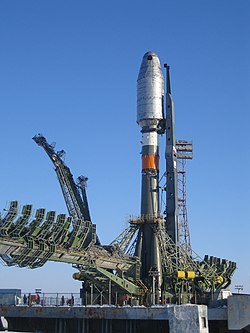Baikonur Cosmodrome Site 31

A Soyuz-2 rocket at LC-31/6.
|
|||||||||||
| Launch site | Baikonur Cosmodrome | ||||||||||
|---|---|---|---|---|---|---|---|---|---|---|---|
| Short name | LC-31/6 | ||||||||||
| Operator | RVSN, VKS, RKA | ||||||||||
| Total launches | TBC | ||||||||||
| Launch pad(s) | 1 | ||||||||||
|
Min / max orbital inclination |
49° – 99° | ||||||||||
|
|||||||||||
| Launch history | |
|---|---|
| Status | Active |
| Launches | TBC |
| First launch | R-7A, 14 January 1961 |
| Associated rockets |
R-7A Vostok Voskhod Polyot Molniya Soyuz Soyuz-L Soyuz-U (current) Soyuz-U2 Soyuz-FG/Fregat (current) Soyuz-2 (current) |
Site 31/6 at the Baikonur Cosmodrome, in Kazakhstan, is a launch site used by derivatives of the R-7 Semyorka missile. From 2011 onwards, it was supposed to be the launch site for manned Soyuz missions to the International Space Station, when launches switched from the Soyuz-FG carrier rocket to the Soyuz-2, which was unable to use the launch pad at Site 1/5. However, Site 1/5 has undergone modifications that allow the manned ISS missions to be launched from it. Only few manned missions to the International Space Station are launched from Site 31/6 (Soyuz TMA-06M, Soyuz TMA-15M, Soyuz MS-02), when Site 1/5 is unavailable.
It was first used on 14 January 1961, for an R-7A ICBM test mission. It is currently used for commercial Soyuz-FG/Fregat missions, and Soyuz-2 launches. In the 1970s and early 1980s, several manned missions were launched from the site.
Coordinates: 45°59′46″N 63°33′51″E / 45.99611°N 63.56417°E
...
Wikipedia
